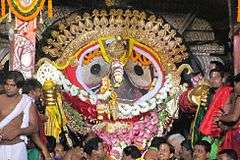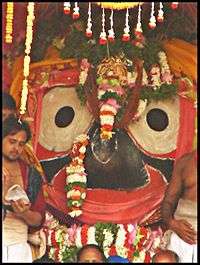List of festivals observed at Jagannatha Temple, Puri

There are elaborate daily worship services. There are many festivals each year attended by millions of people. A large number of traditional festivals are observed by the devotees of Jagannath. Out of those numerous festivals, twelve are important.[1]
- Snana Yatra
- Ratha Yatra or Sri Gundicha Yatra
- Sri Hari Sayan
- Utthapan Yatra
- Parswa Paribartan
- Dakhinayan Yatra
- Prarbana Yatra
- Pusyavishek
- Uttarayan
- Dola Yatra
- Damanak Chaturdasi [2]
- Akshaya Tritiya
Snana Yatra
On the Purnima of the month of Jyestha the Gods are ceremonially bathed and decorated every year on the occasion of Snana Yatra.
Ratha Yatra

Ratha Yatra is most significant of all festivals of Jagannath. The Jagannath triad are usually worshiped in the sanctum of the temple, but once during the month of Asadha (Rainy Season of Odisha, usually falling in month of June or July), they are brought out onto the Bada Danda (The main high street of Puri) and travel (3 km) to the Shri Gundicha Temple, in huge chariots (Rath), allowing the public to have Darshan (Holy view). This festival is known as Ratha Yatra, meaning the festival (Yatra) of the chariots (Ratha). Ratha-Yatra is also termed as the Shri Gundicha yatra.
This spectacular festival includes a procession of three huge chariots bearing the idols of Jagannath, Balabhadra and Subhadra through the Bada Danda meaning the Grand Avenue of Puri till their final destination the Gundicha Temple.[3]
Hera Panchami
Hera Panchami is known as a ritual of Maa Mahalaxmi. Celebrated on the fifth day from Rath Yatra i.e. fifth day in bright fortnight of Ashadha.[4][5]
Hari Sayan
This is the sayana utsav (sleeping ceremony) of the Lord. Sri Hari Sayan festival of Lord Jagannath is observed on the Asadha sukla edadashi (June–July).[6]
Chandan Yatra
In Akshaya Tritiya every year the Chandan Yatra festival marks the commencement of the construction of the Chariots of the Ratha Yatra.
Panchaka
During panchaka lots of people wait for different Beshas of deities.[7] Different vesha like Dalakia vesha, Adakia vesha, Laksmi Nrusingha Vesha,Trivikrama vesha and finally on the day of Kartik Purnima lord is decorated in Rajarajeswara vesha
Nabakalebara
One of the most grandiloquent events associated with the Lord Jagannath, Naba Kalabera takes place when one lunar month of Ashadha is followed by another lunar month of Aashadha. This can take place in 8, 12 or even 18 years.[8] Literally meaning the “New Body” (Nava = New, Kalevar = Body). The event involves installation of new images in the temple[9] and burial of the old ones in the temple premises at Koili Vaikuntha. The idols that are currently being worshipped in the temple premises were installed in the year 1996. Presently in the year of 2015 nabakalebara was held after 19 years.
Anavasara or Anasara
Literally means vacation. Every year, the main idols of Jagannath, Balabhadra, Subhadra & Sudarshan after the holy Snana Yatra on the Jyestha purnima, go to a secret altar named Anavasara Ghar where they remain for the next dark fortnight (krishna paksha). Hence devotees are not allowed to view them. Instead of this devotees go to nearby place Brahmagiri to see their beloved lord in the form of four handed form Alvarnath a form of Vishnu.[10] Then people get the first glimpse of lord on the day before Rath Yatra, which is called 'Nabayaubana. It is said that the gods fall in fever after taking a huge bath and they are treated by the special servants named, Daitapatis for 15 days. During this period cooked food is not offered to the deities.[11]
Niladri Bije
Celebrated on Asadha Trayodashi.[12] Niladri Bije is the concluding day of Ratha yatra. On this day deities return to the ratna bedi.[13] [14] Lord Jagannath offers Rasgulla to goddess Laxmi to enter in to the temple.[15] [16]
Gupta Gundicha
The annual shodasha dinatmaka or 16 day puja beginning 8 days prior to Mahalaya of Ashwin month for goddess Vimala and ending on Vijayadashami, is of great importance, in which both the utsava murty of lord Madanmohan and Vimala take part.
Celebrated for 16 days from Ashwina Krushna dwitiya to Vijayadashami.[17] As per tradition, the idol of Madhaba, along with the idol of Goddess Durga (known as Durgamadhaba), is taken on a tour of the temple premises. The tour within the temple is observed for the first eight days. For the next eight days, the idols are taken outside the temple on a palanquin to the nearby Narayani temple situated in the Dolamandapa lane. After their worship, they are brought back to the temple.[18]
Many festivals like Dol Yatra in spring and Jhulan Yatra in monsoon are celebrated by temple every year.Pavitrotsava and Damanaka utsava are celebrated as per panchanga or panjika. There are special ceremonies in the month of Kartika and Pausha.
- Pana Sankranti: Also known or Vishuva Sankranti and Mesha Sankranti: Special rituals are performed at the temple.[19]
- Chitalagi Amabasya: Also known as Chitau Amabasya celebrated on Srabana Amavasya [20](July–August), the gold and precious stone set Chitas those are removed from the deities on the Snana Purnima (Snana Yatra) night are again adorned on them.[21]
- Deba dipabali: Celebrated for three days from Margasira krushna chaturdashi to shukla pratipada, Jagannath as incarnation of Sri Ram offeres pinda to king Dasarath. On the second day as Krishna he offers Pinda to his original parents Basudev and Devaki and on the third day he offered Pinda to his foster parents Nanda and Jashoda[22]
References
- ↑ Narayan Miśra (1 January 2007). Annals and Antiquities of the Temple of Jagannātha. Sarup & Sons. pp. 143–. ISBN 978-81-7625-747-3. Retrieved 28 December 2012.
- ↑ "Damanaka Chaturdasi - Jagannath Temple". jagannathtemplepuri.com. Retrieved 21 December 2012.
This falls in the month of Chaitra. On this day, the deities pay a visit to the garden of the celebrated Jagannath Vallabha Matha where they pick-up the tender leaves of the Dayanaa unnoticed by anybody.
- ↑ "Rath Yatra 2013 live, Puri". rathyatra.fullorissa.com. Retrieved 22 December 2012.
As part of Rath Yatra, the idols of Lord Puri Jagannath, Lord Balabhadra and Subhadra are taken out in a procession to Gundicha Temple
- ↑ "Hera Panchami – Articles - Jagannath Dham". jagannathdham.com. 2012. Retrieved 25 June 2012.
It is celebrated on Ashada Shukla Panchami, fifth day in bright fortnight of Ashad month in Oriya calendar.
- ↑ "RITUALS OF CAR FESTIVAL OF PURI". Retrieved June 25, 2012.
‘Hera’ means to ‘see’ and ‘Panchami’ means the ‘fifth day’.
- ↑ "Lord Jagannath:Festivals - Sri Hari Sayan, Festival of Lord jagannath, Jagannath Puri , Jagganth Temple of Puri | orissa.oriyaonline.com". orissa.oriyaonline.com. Retrieved 27 December 2012.
Sri Hari Sayan festival of Lord Jagannath is observed on the 11th day of the bright night of Asadha (June–July).
- ↑ "FESTIVALS OF LORD JAGANNATH, BALABHADRA, SUBHADRA,". jagannath.orissaculture.com. 2009. Retrieved 22 December 2012.
PANCHAK VESA - Started from the beginning of 11th day of bright fortnight to Full Moon of Kartika.
- ↑ "Rath Yatra | Jagannath Rath Yatra |". jagannathpuritourism.com. Retrieved 22 December 2012.
These wood logs in every 8-19years in the month of Asadha (June–July) when a leap year fall in the same month as per the lunar calendar.
- ↑ "Jagannath Temple at Puri". templenet.com. Retrieved 22 December 2012.
the wooden images being worshipped are renewed during special occasions
- ↑ "Alarnatha – Articles - Jagannath Dham". jagannathdham.com. 2012. Retrieved 16 May 2012.
peoples believe that Lord Jagannath during this time manifests as Alarnath Dev,
- ↑ "Festivals of Lord Sri Jagannath". nilachakra.org. 2010. Retrieved 16 May 2012.
suffer from fever on the account of elaborate bath and for that they are kept in dietary provisions (No cooked food is served) and are nursed by the Daitas
- ↑ "Festivals of Lord Sri Jagannath". nilachakra.org. 2010. Retrieved 3 July 2012.
NILADRI BIJE - Celebrated on 13th day of bright fortnight of Asadha.
- ↑ "Ocean of devotees on Grand road to witness Sunavesh". news.oneindia.in. 2012. Retrieved 3 July 2012.
entering in to the sanctum sanctorum popularly called called Niladri Bije
- ↑ "Niladri Bije – Lord Jagannath Returning to Shree Mandir | PURIWAVES". puriwaves.nirmalya.in. 2012. Retrieved 3 July 2012.
‘Niladri Bije’, the return journey to Shree Mandir. It is the welcome festival of Lord Jagannath to Shree Mandir
- ↑ "Lord placates wife with sweet delight". vv.telegraphindia.com. Calcutta, India. 2012. Retrieved 3 July 2012.
Lord Jagannath tries to mollify His wife by offering her rasagollas, so that she lets Him enter the temple with His siblings
- ↑ "Lord Jagannath placates angry Mahalakshmi, reenters temple". dailypioneer.com. 2012. Retrieved 3 July 2012.
Jagannath then offers Mahalakshmi rasgullas to placate her and to forgive him
- ↑ Panda, Namita (11 October 2010). "The Telegraph - Calcutta (Kolkata) | Orissa | Gupta Gundicha attracts devotees". telegraphindia.com. Calcutta, India. Retrieved 20 December 2012.
Beginning from Ashwina Krishna dwitiya to the last day of Dusherra,
- ↑ "Gupta Gundicha In Srikhetra – Start of Durga Madhab worshiping | PURIWAVES". puriwaves.nirmalya.in. Retrieved 20 December 2012.
The Vimanbadu servants ( who carry the chariot) carry Sri Durga – Madhab ( Sri Jagannath & Jaya Durga ) in a chariot to the temple of Narayani at Dolamandap Sahi.
- ↑ "Festivals of lord jagannath, puri festivals". fullorissa.com. 2010. Retrieved 16 May 2012.
Pana Sankranti or Mahabishuba sankranti:
- ↑ "Festivals of India - CHITOU AMAVASYA". aryabhatt.com. Retrieved 13 February 2013.
'Chitalagi' or 'Chitou Amavasya' is one such festival, which falls on the new-moon day of the 'Sravana'
- ↑ "Chitalagi Amabasya - Chitalagi Amabasya Festival of Odisha - Chitalagi Amabasya Festival in Odisha". puribeachresorts.com. Retrieved 27 December 2012.
Chitalagi Amabasya is also known as Chitau Amabasya. Chitalagi Amabasya is celebrated on the new moon day of the lunar month of Shravana.
- ↑ "Dev Deepavali at srimandir: Lord remembers ancestors | Orissa Post". orissapost.com. 2012. Retrieved 3 January 2013.
As an incarnation of Sri Ram, he offered ‘pinda’ to king Dasarath. On the second day as Krishna, he offered ‘pinda’ to his parents Basudev and Devaki and on the third day he offered it to his foster parents Nanda and Yashoda.
